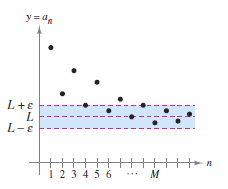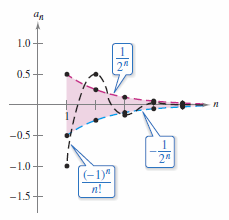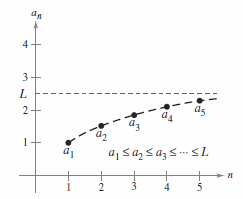Calculus II 09.01 Sequences
| Previous | Calculus II 08 Integration Techniques |
| Next | Calculus II 09.02 Series and Convergence |
Contents
9.1 Sequences
- List the sequence's terms.
- Determine whether a sequence converges or diverges.
- Write a formula for the \(n\)th term in a sequence.
- Use monotonic sequences.
- Use bounded sequences.
Sequences
A mathematical sequence[1] is defined as a function whose domain is the positive integers set. Each item in a sequence is represented by subscript notation rather than by the standard function notation. For example, in the sequence
- $$ \begin{matrix} 1, & 2, & 3, & 4, & \cdots, & n, & \cdots & \\ \color{red}{ \downarrow }& \color{red}{ \downarrow } & \color{red}{ \downarrow } & \color{red}{ \downarrow } & \color{red}{ \downarrow } & \color{red}{ \downarrow } & \color{red}{ \downarrow } & \color{red}{ \text{Sequence} } \\ a_{1}, & a_{2}, & a_{3}, & a_{4}, & \cdots, & a_{n}, & \cdots & \end{matrix}$$
1 maps to \(a_{1}\), 2 maps to \(a_{2}\), and so on. The numbers
- $$ a_{1}, a_{2}, a_{3}, a_{4}, \cdots, a_{n}, \cdots $$
are the sequence's terms. The number \(a_{n}\) is the \(n\)th in the sequence. The entire sequence is denoted by \(\{a_{n}\}\). Sometimes a sequence begins with \(a_{0}\) and the terms become \(a_{0}, a_{1}, a_{2}, a_{3}, a_{4}, \cdots, a_{n}, \cdots \) and the domain is the nonnegative integer set.
Example 9.1.1 Listing a Sequence's Terms
a. The terms for sequence \(\{a_{n}\}=\{3+(-1)^{n}\}\) are
- $$ \begin{matrix} 3+(-1)^{1},& 3+(-1)^{2}, & 3+(-1)^{3}, & 3+(-1)^{4}, & \cdots \\ 2, & 4, & 2, & 4, & \cdots \end{matrix}$$
b. The terms for sequence \(\{b_{n}\}= \{ \frac{n}{1-2n} \} \) are
- $$ \begin{matrix} \frac{1}{1-2 \cdot 1},& \frac{2}{1-2 \cdot 2}, & \frac{3}{1-2 \cdot 3}, & \frac{4}{1-2 \cdot 4}, & \cdots \\ -1, & -\frac{2}{3}, & -\frac{3}{5}, & -\frac{4}{7}, & \cdots \end{matrix}$$
c. The terms for sequence \(\{c_{n}\}=\{ \frac{n^{2}}{2^{n}-1} \}\) are
- $$ \begin{matrix} \frac{1^{2}}{2^{1}-1},& \frac{2^{2}}{2^{2}-1}, & \frac{3^{2}}{2^{3}-1}, & \frac{4^{2}}{2^{4}-1}, & \cdots \\ \frac{1}{1}, & \frac{4}{3}, & \frac{9}{7}, & \frac{16}{15}, & \cdots \end{matrix}$$
d. The terms are recursively defined for sequence \(\{d_{n} \} \), where \(d_{1}=25\) and \(d_{n+1}=d_{n}-5\), are
- $$ \begin{matrix} 25,& 25-5 = 20, & 20-5 = 15, & 15-5=10, & \cdots \end{matrix}$$
Sequence Limits
Sequences whose terms approach limiting values converge. For example, \(\{1/2^{n} \} \)
- $$\frac{1}{2},\frac{1}{4},\frac{1}{8},\frac{1}{16},\frac{1}{32},\cdots$$
converges to 0, as described in Definition 9.9.1
Definition 9.1.1 Sequence Limit
|
Let \(L\) be a real number. The limit for sequence \(\{ a_{n} \} \) is \(L\), written as
if for each \(\varepsilon >0 \), there exists \(M >0 \) such that \( |a_{n} - L| < \varepsilon \) whenever \(n > M\). If the limit \(L\) for a sequence exists, then the sequence converges to \(L\). If the limit for a sequence does not exist, then the sequence diverges. Described graphically, this definition says that eventually, for \(n > M\) and \(\varepsilon >0 \), the sequence terms that converge to \(L\) will lie within the band between the lines \(y=L+\varepsilon\) and \(y=L-\varepsilon\), as shown in Figure 9.1.1. If a sequence \(a_{n} \) agrees with a function \(f\) at every positive integer, and if \(f(x)\) approaches a limit \(L\) as \(x \to \infty\), then the sequence must converge to the same limit \(L\). |
Theorem 9.1.1 Sequence Limit
Let \(L\) be a real number. Let \(f\) be a function for a real variable such that
- $$ \lim_{x \to \infty} f(x) = L.$$
If \(\{ a_{n} \} \) is a sequence such that \(f(n)=a_{n}\) for every positive integer \(n\), then
- $$ \lim_{n \to \infty} a_{n} = L.$$
Example 9.1.2 Finding a Sequence Limit
Find the limit for the sequence whose \(n\)th term is \(a_{n} =(1 + 1/n)^{n}\).
Solution Theorem 5.5.3 describes how
- $$ \lim_{x \to \infty} \left ( 1 + \frac{1}{x} \right )^{x} = e. $$
Apply Theorem 9.1.1 to conclude that
- $$ \lim_{n \to \infty} a_{n} = \lim_{n \to \infty} \left ( 1 + \frac{1}{n} \right )^{n} = e. $$
A sequence can not have a limit if the terms increase or decrease without bound. Both cases are written symbolically below.
- Terms increase without bound: \( \lim_{n \to \infty} a_{n} = \infty \)
- Terms decrease without bound: \( \lim_{n \to \infty} a_{n} = - \infty \)
Theorem 9.1.2 Sequence Limit Properties
These properties parallel the function limits for real variables described in Section 1.3
Let \(\lim_{n \to \infty} a_{n} = L\) and \(\lim_{n \to \infty} b_{n} = K\).
1. \(\lim_{n \to \infty} (a_{n} \pm b_{n}) = L \pm K\)
2. \(\lim_{n \to \infty} ca_{n} = cL\), \(c\) is any real number.
3. \(\lim_{n \to \infty} (a_{n}b_{n}) = LK\)
4. \(\lim_{n \to \infty} \frac{a_{n}}{ b_{n}} = \frac{ L}{ K }\), \(b_{n} \ne 0 \) and \(K \ne 0 \)
Sequence Convergence
Example 9.1.3 Determining Convergence or Divergence
a. Because the sequence \(\{ a_{n} \} = \{ 3+(-1)^{n} \} \) has terms
- 2,4,2,4,...
that alternate between 2 and 4, the limit
- \( \lim_{n \to \infty} a_{n} \) does not exist. The sequence diverges.
b. For \(\{ b_{n} \} = \{ n/(1-2n) \} \), divide the numerator and denominator by \(n\) to obtain
- $$ \lim_{n \to \infty} \frac{n}{1-2n}= \lim_{n \to \infty} \frac{1}{(1/n)1-2} = -\frac{1}{2} $$
which shows the sequence converges to \( -\frac{1}{2} \).
Example 9.1.4 Using L’Hôpital’s Rule to Determine Convergence
Show that the sequence whose \(n\)th term is
- $$ \large a_{n} = \frac{n^{2}}{2^{n}-1} $$
converges.
Solution Cast the function with a real variable
- $$ \large f(x) = \frac{x^{2}}{2^{x}-1}. $$
Applying L’Hôpital’s Rule twice produces
- $$ \large \lim_{x \to \infty} \frac{x^{2}}{2^{x}-1} = \lim_{x \to \infty} \frac{2x}{(\ln 2)2^{x}} = \lim_{x \to \infty} \frac{2}{(\ln 2)^{2}2^{x}}=0$$
Because \(f(n)=a_{n}\) for every positive integer, Theorem 9.1.1 can be applied which produces
- $$ \large \lim_{n \to \infty} \frac{n^{2}}{2^{n}-1} =0.$$
The sequence converges to zero.
The \(n\) factorial symbol, \(n!\), is used to simplify a sequence. Let \(n\) be a positive integer; the \(n\) factorial is defined as
- $$ n!=1 \cdot 2 \cdot 3 \cdot 4 \cdots (n-1) \cdot n.$$
For example, \(1!=1\), \(2!=1 \cdot 2=2\), \(3!=1 \cdot 2 \cdot 3 = 6\), e.t.c. The special case where \(n=0\), zero factorial, is defined as 0!=1. Factorials follow the same conventions for operations order as exponents. Just as \(2x^{3}\) and \((2x)^{3}\) are evaluated differently, so are \(2x!\) and \((2x)!\). As in
- $$ 2n!== 2(n!) = 2(1 \cdot 2 \cdot 3 \cdot 4 \cdots n)$$
and
- $$ (2n)!=1 \cdot 2 \cdot 3 \cdot 4 \cdots (n-1) \cdots n \cdot (n+1) \cdots 2n$$
respectively.
Theorem 9.1.3 Squeeze Theorem for Sequences
This was taken from Section 1.3 and rewritten for sequences.
If \( \lim_{n \to \infty} a_{n} = L = \lim_{n \to \infty} b_{n} \) and there exists an integer \(N\) such that \( a_{n} \leqslant c_{n} \leqslant b_{n} \) for all \( n > N \), then \( \lim_{n \to \infty} c_{n} = L \).
Example 9.1.5 Using the Squeeze Theorem
|
Show that the sequence
converges, and find its limit.
and
This demonstrates that for \(n \geqslant 4\), \( 2^{n} < n!\), which produces
as shown in Figure 9.1.2. By the Squeeze Theorem, it follows that
|
Example 9.1.5 suggests something interesting about the rate at which \(n!\) increases as \(n \to \infty \). In Figure 9.1.2 both \(1/2^{n}\) and \(1/n!\) both approach 0 as \(n \to \infty\). Yet \(1/n!\) approaches 0 so much faster than \(1/2^{n}\) does that
- $$ \lim_{n \to \infty} \frac{ 1/n!}{1/2^{n}} = \lim_{n \to \infty} \frac{2^{n}}{n!} = 0. $$
It can be proven that for any fixed number \(k\), \(\lim_{n \to \infty} (k^{n}/n!) = 0\). This means that the factorial function grows faster than any exponential function.
In Example 9.1.5 the sequence \( \{ c_{n} \} \) has both positive and negative terms. For this sequence, it happens that the absolute values, \( \{|c_{n}|\} \), also converges to 0. Using the Squeeze Theorem and the inequality
- $$ 0 \leqslant \frac{1}{n!} \leqslant \frac{1}{2^{n}}, \: n \geqslant 4. $$
This leads to Theorem 9.1.4, which states that if the absolute value sequence converges to 0, then the original signed sequence also converges to zero.
Theorem 9.1.4 Absolute Value Theorem
For the sequence \( \{a_{n}\} \), if
- $$ \lim_{n \to \infty} |a_{n}| =0 \text{ then } \lim_{n \to \infty} a_{n} =0 $$
Proof Consider the two sequences \( \{|a_{n}|\} \) and \( \{-a_{n}\} \). Because both sequences converge to 0 and
- $$ -|a_{n}| \leqslant a_{n} \leqslant |a_{n}| $$
using the Squeeze Theorem to conclude that \( \{a_{n}\} \) converges to 0.
Pattern Recognition for Sequences
For some sequences the generating function is unknown and only the terms are available and the \(n\)th term is not identified. Finding the generating function, and thus the \(n\)th term, requires finding a pattern in the sequence that can describe the \(n\)th term. Once the \(n\)th term has been specified, the sequence's convergence or divergence can be investigated.===
Example 9.1.6 Finding the \(n\)th Term for a Sequence
Find a sequence \( a_{n} \) whose first five terms are
- $$ \frac{2}{1}, \frac{4}{3}, \frac{8}{5}, \frac{16}{7}, \frac{32}{9}, \cdots $$
and then determine if the sequence converges or diverges.
Solution First look for patterns in the numerators and denominators. The numerators are all successive powers of 2 with no gaps. The denominators are all odd prime numbers, positive odd integers. By comparing \( a_{n} \) with \(n\) within the given terms the following pattern emerges
- $$ \frac{2^{1}}{1}, \frac{2^{2}}{3}, \frac{2^{3}}{5}, \frac{2^{4}}{7}, \frac{2^{5}}{9}, \cdots, \frac{2^{n}}{2n-1}, \cdots $$
Consider the function for a real variable \(f(x)=2^{x}/(2x-1)\). Applying L’Hôpital’s Rule produces
- $$ \large \lim_{x \to \infty} \frac{2^{x}}{2x-1} = \lim_{x \to \infty} \frac{2^{x}(\ln 2)}{2} = \infty.$$
Now apply Theorem 9.1.1 to conclude that
- $$ \large \lim_{n \to \infty} \frac{2^{n}}{2n-1} = \infty. $$
Thus the sequence diverges.
The first few terms are not enough to determine a pattern, and thus a generating function, for a sequence. In the four sequences below all the first three terms are identical. But the first two sequences converge to 0, the third sequence converges to \(1/9\) and the last sequence diverges.
- $$ \{a_{n}\}: \frac{1}{2}, \frac{1}{4}, \frac{1}{8}, \frac{1}{16}, \cdots , \frac{1}{2^{n}}, \cdots $$
- $$ \{b_{n}\}: \frac{1}{2}, \frac{1}{4}, \frac{1}{8}, \frac{1}{15}, \cdots , \frac{6}{(n+1)(n^{2}-n+6)}, \cdots $$
- $$ \{c_{n}\}: \frac{1}{2}, \frac{1}{4}, \frac{1}{8}, \frac{7}{62}, \cdots , \frac{n^{2}-3n+3}{9n^{2}-25n+18}, \cdots $$
- $$ \{d_{n}\}: \frac{1}{2}, \frac{1}{4}, \frac{1}{8}, 0, \cdots , \frac{-n(n+1)(n-4)}{6(n^{2}+3n-2)}, \cdots $$
Inductive reasoning is the process for determining an \(n\)th term from the pattern observed in a sequence's first several terms.
Example 9.1.7 Finding the \(n\)th Term for a Sequence
Determine the \(n\)th term for a sequence whose first five terms are
- $$ -\frac{2}{1}, \frac{8}{2}, -\frac{26}{6}, \frac{80}{24}, -\frac{242}{120}, \cdots $$
and then find if the sequence converges or diverges.
Solution Note the numerators are all 1 less than \(3^{n}\).
- $$ 3^{1}-1=2\:\:\: 3^{2}-1=8\:\:\: 3^{3}-1=26\:\:\: 3^{4}-1=80\:\:\: 3^{5}-1=242\:\:\:$$
This is strong evidence the numerators are given the rule
- $$ 3^{n}-1.$$
Factoring the denominators produces
| \( 1 \) | \(=1\) |
| \( 2 \) | \(=1 \cdot 2\) |
| \( 6 \) | \(=1 \cdot 2 \cdot 3 \) |
| \( 24 \) | \(=1 \cdot 2 \cdot 3 \cdot 4 \) |
| \( 120 \) | \(=1 \cdot 2 \cdot 3 \cdot 4 \cdot 5. \) |
This is strong evidence the denominators are given by the rule \(n!\). Because the signs alternate prefix with \((-1)^{n}\).
- $$ a_{n}= (-1)^{n} \left ( \frac{3^{n}-1}{n!} \right ).$$
From the growth rate for \(n!\) in Example 9.1.5 it follows that
- $$ \lim_{n \to \infty} |a_{n}| = \lim_{n \to \infty} \frac{3^{n}-1}{n!} = 0. $$
Applying Theorem 9.1.4 produces
- $$ \lim_{n \to \infty} a_{n} = 0. $$
Thus the sequence \( \{a_{n}\} \) converges to 0.
Monotonic Sequences and Bounded Sequences
Theorem 9.1.5 provides a test for convergence for sequences without determining the limit. Before Theorem 9.1.5 Bounded and Monotonic sequences must be defined and described.
Definition 9.1.2 Monotonic Sequences
A sequence \( \{a_{n}\} \) is monotonic when its terms are nondecreasing
- $$ a_{1} \leqslant a_{2} \leqslant a_{3} \leqslant \cdots \leqslant a_{n} \leqslant \cdots $$
or when its terms are nonincreasing
- $$ a_{1} \geqslant a_{2} \geqslant a_{3} \geqslant \cdots \geqslant a_{n} \geqslant \cdots. $$
Example 9.1.8 Determining Whether a Sequence Is Monotonic
|
Determine whether each sequence having the given \(n\)th term is monotonic.
This sequence is monotonic because each successive term is greater than its predecessor. |
Definition 9.1.3 Bounded Sequence
1. A sequence \( \{a_{n}\} \) is bounded above when there is a real number \(M\) such that an \(a_{n} \leqslant M\) for all \(n\). The number \(M\) is called the sequence's upper bound.
2. A sequence \( \{a_{n}\} \) is bounded below when there is a real number \(N\) such that \(N \leqslant a_{n} \) for all \(n\). The number \(N\) is called the sequence's lower bound.
3. A sequence \( \{a_{n}\} \) is bounded when it is bounded above and bounded below.
In Example 9.1.3 all three sequences are bounded as shown below
- $$ 2 \leqslant a_{n} \leqslant 4, \:\:1 \leqslant b_{n} \leqslant 2, \text{ and } 0 \leqslant c_{n} \leqslant \frac{4}{3}. $$
A set is complete when there are no gaps among the terms. For example, the real numbers are complete because there are no gaps in the real number line. The rational number set does not have the completeness property. The completeness axiom for real numbers can be used to conclude that if a sequence has an upper bound, then it must have a least upper bound (an upper bound that is less than all other upper bounds for the sequence). For example, the least upper bound of the sequence \( \{a_{n}\} = \{n/(n+1)\} \),
- $$\frac{1}{2},\:\frac{2}{3},\:\frac{3}{4},\:\frac{4}{5},\:\cdots,\frac{n}{n+1},\:\cdots $$
is 1. The completeness axiom is used to prove Theorem 9.1.5.
Theorem 9.1.5 Bounded Monotonic Sequences
If a sequence \( \{a_{n}\} \) is bounded and monotonic, then it converges.
Proof Assume the sequence is nondecreasing, as shown in Figure 9.1.4. For simplicity, also assume that each term in the sequence is positive. Because the sequence is bounded, there must exist an upper bound \(M\) such that
- $$ a_{1} \leqslant a_{2} \leqslant a_{3} \leqslant \cdots \leqslant a_{n} \leqslant \cdots \leqslant M.$$
From the completeness axiom, it follows that there is a least upper bound such that
- $$ a_{1} \leqslant a_{2} \leqslant a_{3} \leqslant \cdots \leqslant a_{n} \leqslant \cdots \leqslant L.$$
For \( \varepsilon > 0\), it follows that \(L - \varepsilon < L\), and therefore \(L - \varepsilon \) cannot be an upper bound for the sequence. Consequently, at least one term for \( \{a_{n}\} \) is greater than \( L - \varepsilon \). That is, \(L-\varepsilon < a_{N}\) for some positive integer \(N\). Because the terms for \( \{a_{n}\} \) are nondecreasing, it follows that \( a_{N} \leqslant a_{n}\) for \(n >N\). Since \(L-\varepsilon<a_{N} \leqslant a_{n} \leqslant L < L+ \varepsilon \), for every \(n>N\). It follows that \(|a_{n}-L|<\varepsilon\) for \(n >N\), which by definition means that \( \{a_{n}\} \) converges to \(L\). The proof for a nonincreasing sequence is similar.
Example 9.1.9 Bounded and Monotonic Sequences
|
a. The sequence \( \{a_{n}\} = \{1/n\} \) is both bounded and monotonic, and so, by Theorem 9.1.5, it must converge. |
Internal Links
Parent Article: Calculus II 09 Infinite Series



